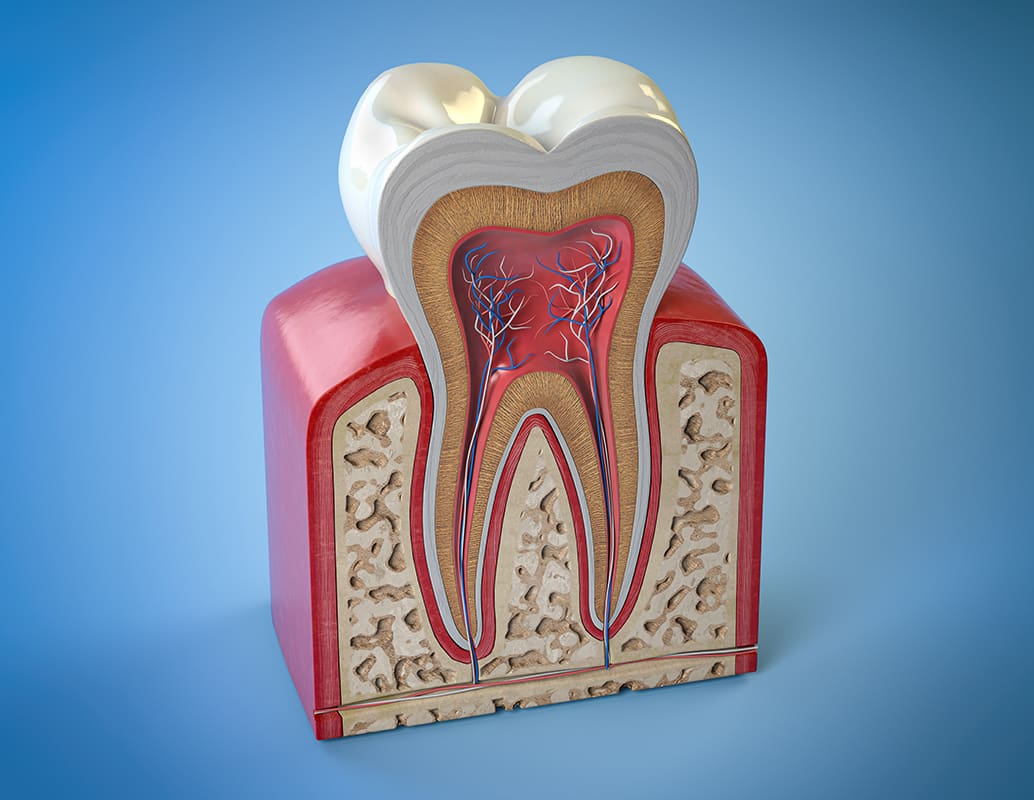Pulpotomy (Baby Root Canal)

About Pulpotomy (Baby Root Canal)
A pulpotomy, also known as a baby root canal, is a pediatric dental procedure that involves the partial removal of the coronal pulp in a decayed or infected baby tooth.
It is performed to alleviate tooth pain, preserve the remaining healthy dental pulp, and maintain the integrity of the primary tooth until it naturally falls out.
Key Takeaway
A pulpotomy is a common dental procedure that involves removing the affected portion of the pulp in primary teeth to prevent further infection and preserve the natural tooth. It offers several benefits such as saving the tooth, preserving healthy pulp tissue, and preventing future issues.
Why is a Pulpotomy Needed?

A tooth is made up of different layers – the outermost layer is called enamel, followed by dentin and finally, the innermost layer known as the pulp.
The pulp contains nerves, blood vessels, and connective tissue that provide nourishment to the tooth and help it grow during development.
A pulpotomy may be necessary when dental decay or trauma reaches the pulp chamber of a primary tooth, leading to inflammation or infection of the pulp.
The pulpotomy procedure is performed as an effective alternative to root canal treatment or tooth extraction, aiming to save the natural tooth and promote dental health in children.
Root Canal vs Pulpotomy
Root canal treatment involves the complete removal of the pulp from a tooth, including both the coronal and root portions.
A pulpotomy, on the other hand, only removes the inflamed or infected portion of the pulp in primary teeth.
Benefits of a Pulpotomy
A pulpotomy is an effective way to maintain oral health and prevent future issues. Here are some key benefits:
- Saves the natural tooth: A pulpotomy allows the primary tooth to remain in place until it falls out naturally, preventing premature loss and preserving space for permanent teeth.
- Preserves healthy pulp tissue: By removing only the affected portion of the pulp, a pulpotomy maintains the vitality and function of the remaining healthy dental pulp.
- Prevents further infection: Removing infected or inflamed tissue from the tooth can prevent the spread of bacteria and reduce the risk of future infections.
The Pulpotomy Procedure
The following are the general steps involved in a pulpotomy procedure when performed at our pediatric dental office.
Step 1: Assessment and Preparation
We will conduct a thorough examination to assess the extent of the decay or infection in the affected tooth. Digital dental X-rays may be taken to evaluate the condition of the dental pulp and surrounding structures. If a pulpotomy is deemed the appropriate treatment, we will explain the procedure and address any concerns or questions.
Step 2: Local Anesthesia and Sedation
Local anesthesia is administered to numb the tooth. We offer the NuSmile Soan Cordless Electronic Injection Pen. This painless injection system delivers anesthesia at a controlled rate to numb the area around the affected tooth.
In some cases, we may recommend dental sedation to help your child relax during the procedure. We offer nitrous oxide (laughing gas) and IV sedation.
Step 3: Access and Pulp Chamber Treatment
Once the tooth is numbed and the child is comfortable, we will remove the decayed portion of the tooth, gaining access to the pulp chamber. The inflamed or infected pulp tissue is carefully removed, leaving the healthy pulp stumps intact.
Step 4: Medication and Restoration
A medicated material is placed in the pulp chamber to promote healing and prevent bacterial growth. We will then restore the tooth with a dental crown to seal, protect, and restore the tooth.
Aftercare and Recovery
Following a pulpotomy, your child may experience some mild discomfort or sensitivity for a few days. Over-the-counter pain medication and cold compresses can help relieve any discomfort.
It is important to continue practicing good oral hygiene habits, such as brushing twice a day and flossing daily, to maintain the health of the treated tooth.
Risks and Complications
As with any dental procedure, there are some risks associated with a pulpotomy. These include:
- Incomplete removal of infected pulp tissue.
- Damage to surrounding teeth or structures.
- Allergic reaction to medication used during the procedure.
If your child experiences severe pain, swelling, or fever after a pulpotomy, please contact our office immediately.
How to Prepare Your Child For a Pulpotomy Procedure
Preparing your child for a pulpotomy procedure can help alleviate anxiety and ensure a smoother experience.
Here are some helpful tips to help you prepare your child for the procedure:
- Don’t overexplain before the visit: Let them know that the dentist will explain the procedure to them before they begin. We have perfected explaining the procedure to children in a way that is age appropriate and informative without causing undue fear and anxiety.
- Answer questions: Encourage your child to ask questions and address any concerns they may have. Reassure them that the dental team will take good care of them throughout the procedure.
- Choose comfortable clothing: Dress your child in comfortable and loose-fitting clothing on the day of the pulpotomy.
- Bring a comfort item: If your child has a favorite toy, blanket, or stuffed animal, allow them to bring it along to the appointment. Having a familiar item can provide comfort and a sense of security during the procedure.
- Follow pre-procedure instructions: Ensure that you follow any pre-procedure instructions provided by the dental office. This may include fasting or avoiding certain foods or beverages prior to the appointment.
- Arrive early: Arrive a little earlier than the scheduled appointment time. This will give your child some time to acclimate to the environment and reduce any rushing or additional stress.
Offer support and reassurance: Be there to offer support and reassurance to your child throughout the process. Your presence and calming words can go a long way in easing their anxiety.
Our experienced dentists, Dr. Kate Stanley and Dr. Alex Cook Schmidt, are dedicated to providing compassionate and comprehensive dental care for children of all ages.
We understand that a pulpotomy may be a daunting experience for both you and your child, but rest assured that we will do everything possible to ensure a comfortable and successful procedure.
If you have any questions or concerns about your child’s oral health or the pulpotomy procedure, please don’t hesitate to contact us. We are always accepting new patients and look forward to being your trusted pediatric dental provider in Overland Park.
To book an appointment at our pediatric dental office in Overland Park, KS, call (913) 345-0331 or complete the online inquiry form. We look forward to helping your child achieve a healthy and happy smile!
FAQS
Is it worth doing a root canal on a baby tooth?
Yes, it is worth it to do a root canal on a baby tooth. Primary teeth (baby teeth) play a crucial role in a child’s overall development, including their ability to chew and speak properly. Premature loss of baby teeth can also lead to orthodontic issues in the future. Saving a tooth through a pulpotomy can help maintain proper function and alignment until the permanent tooth is ready to erupt.
What is the difference between a root canal and a baby root canal?
A root canal is a procedure that removes all pulp tissue from an adult tooth, while a baby root canal (pulpotomy) is a procedure that removes infected pulp tissue from a primary (baby) tooth, but leaves the healthy pulp tissue in the roots. The procedures differ slightly in terms of the amount of pulp tissue removed and the type of restoration used to restore the tooth. The goal of both procedures is to save the affected tooth.
What is the youngest age for a root canal?
The youngest age for a root canal varies and is dependent on several factors, including the child’s overall health and development, the extent of tooth decay or damage, and their ability to cooperate during the procedure. In most cases, a pulpotomy can be performed as early as two years old.
How long does a baby root canal take?
A baby root canal typically takes about 30 minutes to complete. However, the length of the procedure may vary depending on the child’s cooperation and the extent of dental work needed.

